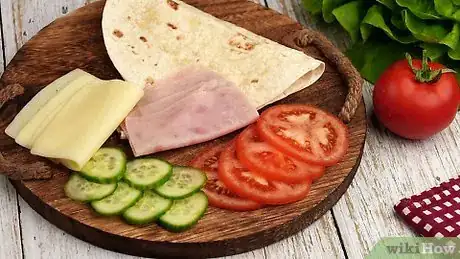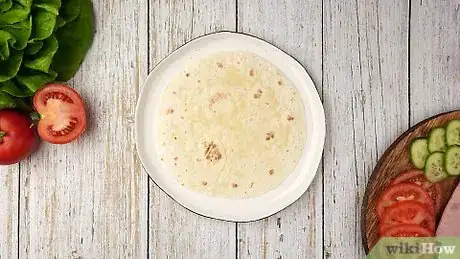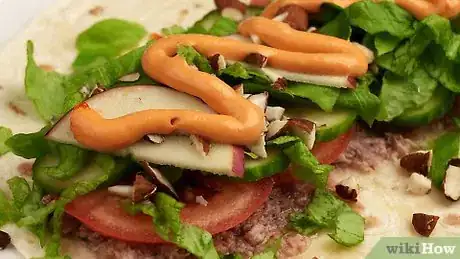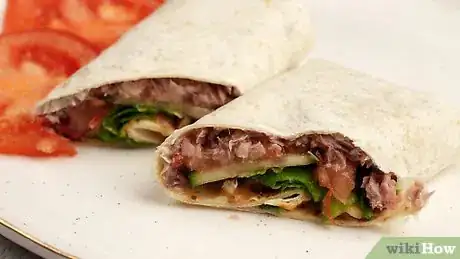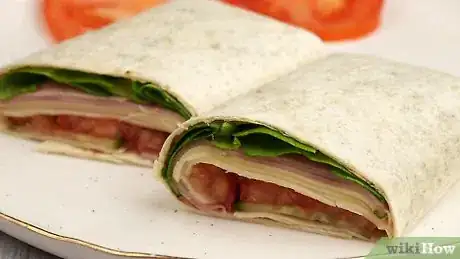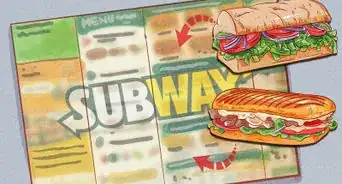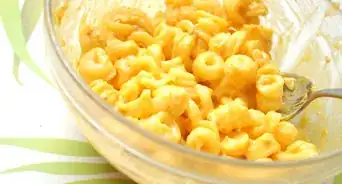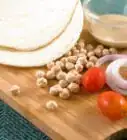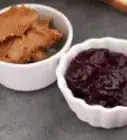wikiHow is a “wiki,” similar to Wikipedia, which means that many of our articles are co-written by multiple authors. To create this article, 22 people, some anonymous, worked to edit and improve it over time.
The wikiHow Culinary Team also followed the article's instructions and verified that they work.
This article has been viewed 491,395 times.
Learn more...
Lots of restaurants are offering wraps, basically sandwiches (and sometimes salads) in a tortilla. They're easy to make, though, and require no cooking experience. So stay home or brown bag your lunch and save money, eat healthily, and have fun trying all kinds of different combinations.
Steps
Choosing the Ingredients
-
1Choose your ingredients. The next time you're at the market, look for foods you like. A good rule of thumb is that if they would work well in a sandwich, they would work well in a wrap, but because a wrap is enclosed, you can also include things that might not handle well on a sandwich.
-
2Lay out a tortilla. The anchor for a good wrap is usually a large flour tortilla, though you can use corn if you prefer them. You may be able to find colorful variations that include things like tomatoes or spinach. If you don't want to buy tortillas, or you can't find them, remember that you can also make your own.
- Whatever tortilla you use, lay it on a plate or clean cutting board and arrange the contents on top of it.
- Warm the tortilla in a pan with a bit of oil, if you want it warm.
Meat and Fish Fillings
-
1Add meats, if you eat them. You can use cold cuts or you can prepare your own meat by grilling, pan-frying, or any other method you want. Don't forget to season the meat if you're cooking it yourself. Chicken, turkey, beef, ham, and pork are casual options.
-
2Add seafood, if you like it. Shrimp and fish make good, lighter additions to wraps. You can also use canned tuna or salmon, inside or outside of a tuna salad mixture.
- Generally, use meats or seafood. Seafood tends to have more of a delicate flavor and texture that can be overwhelmed by heavier meats.
Vegetable or Fruit Fillings
-
1Add veggies, pile them high. The sky is the limit, metaphorically, so try all kinds of things. This is a great way to pack some delicious nutrition into a compact package. You can make an entire portable salad right there inside the tortilla if you want.
- Try lettuce of all kinds, spinach, sprouts, chopped bell pepper (cooked or raw), broccoli (steam it lightly if you prefer), tomatoes, olives, mushrooms, and anything else you like.
-
2Try fruits, fresh or dried. While they're not as frequent an addition to sandwiches or salads, you may find you like the bit of sweetness or tartness that fruits add. Try bits of pear or apple, grapes, raisins, or any other fruit you think might taste good with your combination of fillings.
Other Fillings and Seasonings
-
1Add nuts and/or seeds. Slivered almonds, toasted, chopped walnuts, sunflower seeds, or sesame seeds can add a pleasant crunch and a bit of elegance to your wrap.
-
2Add cheese, dressings or other condiments. Watch the fat content if you're dieting. If you love mayonnaise, cheese, cream cheese, or ranch dressing, you can compromise and use a smaller portion. Otherwise, try to add flavor with less fatty foods. Try mustard, barbecue sauce, low fat sour cream, yogurt, kefir, light salad dressings, or oil and vinegar.
-
3Add any seasonings you want. Salt and pepper are common choices, but don't forget other fresh or dried herbs and spices, like basil, oregano, cinnamon, or chili powder.
Wrapping the Wrap
-
1Visually divide the wrap into three strips. Place the fillings down the center strip, stopping short of the ends. Fold about three inches of each end in toward the middle. Then roll the rest of the tortilla over around the fillings. Roll snugly.
-
2For a restaurant look, slice the entire wrap in half on a diagonal.
-
3Finished.
Shopping List and Recipe
Community Q&A
-
QuestionHow can I keep my sandwich wraps from becoming soggy overnight?
 Community AnswerKeep them secured inside cling film, then keep them in the fridge overnight.
Community AnswerKeep them secured inside cling film, then keep them in the fridge overnight. -
QuestionWhat kind of sauce do I use in a chicken wrap?
 Community AnswerTry not use any runny sauces because when mixed with the chicken juices it makes the tortilla soggy.That said, you can can use anything you want. Just try not to use overpowering sauces like ketchup, mustard or brown sauce.
Community AnswerTry not use any runny sauces because when mixed with the chicken juices it makes the tortilla soggy.That said, you can can use anything you want. Just try not to use overpowering sauces like ketchup, mustard or brown sauce. -
QuestionWhat is the best tortilla to use for rolled sandwiches?
 Community AnswerWhile there's not a whole lot of difference between them, some are thicker and may hold your fillings better. Flour tortillas may be easier to use for wraps because they are more flexible than corn tortillas.
Community AnswerWhile there's not a whole lot of difference between them, some are thicker and may hold your fillings better. Flour tortillas may be easier to use for wraps because they are more flexible than corn tortillas.
Warnings
- Handle food safely, especially meats. Make sure meats are cooked thoroughly. If you are carrying a wrap in your lunch box, refrigerate it when you arrive or use an insulated lunch box and an ice pack.⧼thumbs_response⧽
About This Article
To make a sandwich wrap, start by laying a large flour tortilla flat on a plate or cutting board. Next, add some meats or cheeses on top of it, such as cold cuts or tuna salad. Then, pile on veggies, like lettuce, tomatoes, or spouts, down the center of the tortilla. You can also add in mayonnaise, mustard, and other condiments if you want to. Finally, fold either side of the tortilla toward the center to hold in the fillings and cut the wrap in half horizontally before serving it. For tips on how to make a classic ham, lettuce, and tomato Wrap, read on!
